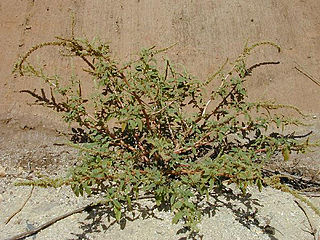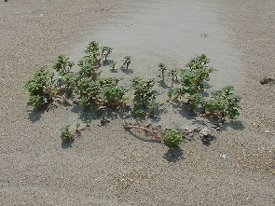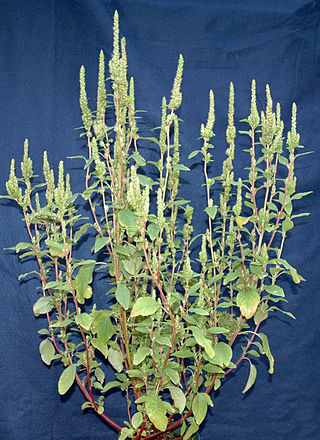
Amaranthus is a cosmopolitan genus of annual or short-lived perennial plants collectively known as amaranths. Some amaranth species are cultivated as leaf vegetables, pseudocereals, and ornamental plants. Catkin-like cymes of densely packed flowers grow in summer or fall. Amaranth varies in flower, leaf, and stem color with a range of striking pigments from the spectrum of maroon to crimson and can grow longitudinally from 1 to 2.5 metres tall with a cylindrical, succulent, fibrous stem that is hollow with grooves and bracteoles when mature. There are approximately 75 species in the genus, 10 of which are dioecious and native to North America with the remaining 65 monoecious species endemic to every continent from tropical lowlands to the Himalayas. Members of this genus share many characteristics and uses with members of the closely related genus Celosia. Amaranth grain is collected from the genus. The leaves of some species are also eaten.

Amaranthus blitum, commonly called purple amaranth or Guernsey pigweed, is an annual plant species in the economically important plant family Amaranthaceae.

Amaranthus hybridus, commonly called green amaranth, slim amaranth, smooth amaranth, smooth pigweed, or red amaranth, is a species of annual flowering plant. It is a weedy species found now over much of North America and introduced into Europe and Eurasia.

Amaranthus hypochondriacus is an ornamental plant commonly known as Prince-of-Wales feather or prince's-feather. Originally endemic to Mexico, it is called quelite, bledo and quintonil in Spanish.

Amaranthus spinosus, commonly known as the spiny amaranth, spiny pigweed, prickly amaranth or thorny amaranth, is a plant that is native to the tropical Americas, but is present on most continents as an introduced species and sometimes a noxious weed. It can be a serious weed of rice cultivation in Asia.

Amaranthus albus is an annual species of flowering plant. It is native to the tropical Americas but a widespread introduced species in other places, including Europe, Africa and Australia.

Species belonging to the genus Amaranthus have been cultivated for their grains for 8,000 years. Amaranth plants are classified as pseudocereals that are grown for their edible starchy seeds, but they are not in the same botanical family as true cereals, such as wheat and rice. Amaranth species that are still used as a grain are Amaranthus caudatus L., Amaranthus cruentus L., and Amaranthus hypochondriacus L. The yield of grain amaranth is comparable to that of rice or maize.

Amaranthus blitoides, commonly called mat amaranth, prostrate pigweed, procumbent pigweed, prostrate amaranth, or matweed, is a glabrous annual plants species. It usually grows up to 0.6 m, though it may grow up to 1 m. It flowers in the summer to fall.

Salix lasiolepis is a species of willow native to western North America.

Amaranthus graecizans, the Mediterranean amaranth or short-tepalled pigweed, is an annual species in the botanical family Amaranthaceae. It is native to Africa, southern Europe, East Asia to India and Central Asia. It is naturalized in North America. More general common names include tumbleweed and pigweed.

Amaranthus pumilus, the seaside amaranth or seabeach amaranth, is a species of amaranth. This annual plant is now a threatened species, although it was formerly scattered along the eastern coast of the United States, its native range.

Nolina bigelovii is a flowering plant native to the Southwestern United States, California, and northwest Mexico. It grows in the driest desert areas and at elevations up to 1,500 metres (4,900 ft).

Scoliopus, or fetid adderstongue, is a genus of plant within the family Liliaceae consisting of two species, Scoliopus bigelovii and S. hallii. Both are found in deep shaded forests, primarily in the coastal counties of the western United States from central California to northern Oregon. The name "Scoliopus" derives from the Greek words skolios and pous, meaning curved foot, a reference to the shape of the pedicel. Taxonomists believe that Scoliopus is closely related to Calochortus, Prosartes, Streptopus and Tricyrtis, which all have creeping rhizomes as well as styles that divide at the tip.

Amaranthus powellii is a species of amaranth known by the common names Powell's amaranth and green amaranth.

Selaginella bigelovii is a species of spikemoss known by the common names bushy spikemoss and Bigelow's spikemoss. It is native to California and Baja California, where it grows in rocky places in many different habitat types, from the coastline to the mountains to the deserts. This lycophyte forms clumps of spreading upright to erect stems up to 20 centimeters long with a few short lateral branches. The linear or lance-shaped green leaves are up to 4 millimeters long, including the tiny rigid bristles at their tips. They are flattened to the stem or stick out just a little. The strobili borne at the leaf bases are yellow-orange in color.
Bahia bigelovii, or Bigelow's bahia, is a North American species of flowering plants in the family Asteraceae. It is native to the State of Coahuila in Mexico and to the western (trans-Pecos) part of the US state of Texas.

Bidens bigelovii is a North American species of flowering plant in the family Asteraceae. It is native to the southwestern and south-central United States and to Mexico as far south as Oaxaca.
Chromolaena bigelovii called Bigelow's false thoroughwort, or Bigelow's thoroughwort, is a North American species of flowering shrub in the family Asteraceae. It is native to northeastern Mexico and the US State of Texas.

Dieteria bigelovii, also known as Bigelow's tansyaster or sticky aster, is a North American species of plants in the family Asteraceae.
A. bigelovii may refer to:
















